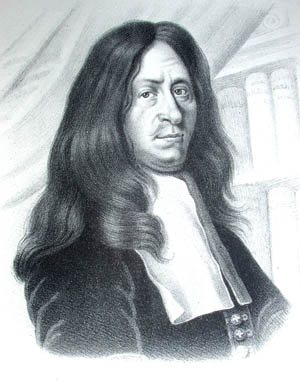<Back to Index>
- Physician Thomas Bartholin, 1616
- Painter Aelbert Jacobsz Cuyp, 1620
- Prime Minister of the United Kingdom Henry John Temple, 3rd Viscount Palmerston, 1784
PAGE SPONSOR

Thomas Bartholin (Thomas Bartolinus) (20 October 1616 – 4 December 1680) was a Danish physician, mathematician, and theologian. He is best known for his work in the discovery of the lymphatic system in humans and for his advancements of the theory of refrigeration anesthesia, being the first to describe it scientifically.
Thomas
Bartholin came from a family that has become famous for its pioneering
scientists, twelve of whom became professors at the University of Copenhagen.
Three generations of the Bartholin family made significant
contributions to anatomical science and medicine in the 17th and 18th
centuries: Thomas Bartholin's father, Caspar Bartholin the Elder (1585-1629), his brother Rasmus Bartholin (1625-1698), and his son Caspar Bartholin the Younger (1655 – 1738). In December 1652, Bartholin published the first full description of the human lymphatic system. Jean Pecquet had previously noted the lymphatic system in animals in
1651, and Pecquet's discovery of the thoracic duct and its entry into
the veins made him the first person to describe the correct route of
the lymphatic fluid into the blood. Shortly
after the publication of Pecquet's and Bartholin's findings, a similar
discovery of the human lymphatic system was published by Olof Rudbeck in
1653, although Rudbeck had presented his findings at the court of Queen
Christina of Sweden in April-May 1652, before Bartholin, but delayed in
writing about it until 1653 (after Bartholin). As a result, an intense
priority dispute ensued. Niels Stensen or Steno became his most famous pupil. Thomas and Rasmus Bartholin's publication De nivis usu medico observationes variae Chapter XXII, contains the first known mention of refrigeration anaesthesia, a technique whose invention Thomas Bartholin credits to the Italian Marco Aurelio Severino of
Naples. According to Bartholin, Severino was the first to present the
use of freezing mixtures of snow and ice (1646), and Thomas Bartholin
initially learnt about the technique from him during a visit to Naples. Bartholin-Patau syndrome, first described by Thomas Bartholin, is a congenital syndrome of multiple abnormalities produced by trisomy of chromosome number 13. Caspar
Bartholin the Elder, Thomas Bartholin's father; his brother Rasmus
Bartholin; and his son Caspar Bartholin the Younger, all contributed in
crucial ways to the practice of modern medicine through their
discoveries of important anatomical structures and phenomena. Bartholin
the Elder started his tenure as professor at Copenhagen University in
1613, and over the next 125 years, the scientific accomplishments of
the Bartholin while serving on the medical faculty of the University of Copenhagen won international acclaim and contributed to the reputation of the institution. Thomas Bartholin was the second of the six sons of Caspar Bartholin the Elder, a physician born in Malmö, Scania, and
his spouse Anne Fincke. Bartholin the Elder published the first
collected anatomical work in 1611. This work was later illustrated and
revised by Thomas Bartholin, becoming the standard reference on anatomy. Bartholin visited the Italian botanist Pietro Castelli at Messina in 1644. In 1663 Bartholin bought Hagestedgaard, which burned down in 1670 including his library, with the loss of many manuscripts. King Christian V of Denmark appointed
Bartholin as his physician with a substantial salary and freed the farm
from taxation as recompense for the loss. In 1680 Bartholin's health
failed, the farm was sold, and he moved back to Copenhagen, where he
died. He was buried in Vor Frue Kirke (Church of Our Lady). The sublingual gland's
major duct is named after Thomas Bartholin's brother Rasmus Bartholin;
it is referred to as the sublingual duct of Bartholin. The Bartholinsgade, a street in Copenhagen, is named for the family. Nearby is the Bartholin Institute (Bartholin Institutet).